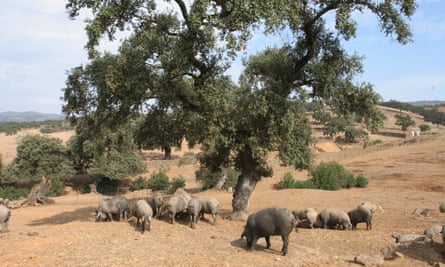Having discovered the joys of French wine, caviar and truffles, China’s new rich are turning to a new gourmet delicacy to satisfy their demand for luxury goods from the west: Spain’s jamón ibérico, or Iberian ham. But demand is now threatening to outstrip supply, leaving Spaniards facing steep price rises in their most prized Christmas delicacy.
The recent lifting of import restrictions has allowed top-of-the-range ham to find its “rightful place in the market, alongside caviar and truffles”, René Lemée, the head of exports for the famous Cinco Jotas brand, told El País newspaper.
The Chinese, pork lovers par excellence, have now been seduced by jamón ibérico. The problem is that the best ham takes years to produce and, as demand outstrips supply, it is pushing up the price by as much as 10%. A 7.5kg leg sells at between €150 and €600 (£135-£540).
Spanish ham comes in many forms, but to be defined as jamón ibérico de bellota (acorn-fed Iberian ham), which is what the Chinese want, it must first come from Iberian blackfoot pigs, or from 50% crossbreeds. These pigs must then spend several months of the year roaming the dehesa, a pasture planted with oaks, feeding on grass and acorns. During the last few months before being slaughtered they must live exclusively on this diet.

Not only are there relatively small areas of dehesa – mostly in north-west and western Spain – but each pig needs about two hectares (five acres) to fulfil its needs. Once slaughtered, the animals’ legs are plunged into vats of salt and hung and dry-cured over a range of temperatures for a minimum of 36 months, with the best hams cured for about 48 months.
“It’s inevitable that the price in Spain is going to rise,” said Roberto Batres, the director of Shanghai de Delaiberia Gold, which exports ham, wine and olive oil to China. “The companies licenced to trade in China don’t have enough jamón de bellota to meet Chinese demand.”
In an effort to meet demand the Chinese have started importing raw frozen pork from Iberian pigs and curing the meat themselves, although Batres says the product is excessively salty.
The production and consumption of top-quality ham is the subject of the same awe and mystery as the making of fine wine. Cutting de-boned jamón de bellota on a ham-slicing machine is regarded as sacrilege. The leg must be bolted on to a frame called a jamonero and then cut by hand using a long, narrow blade. Most towns in the ham-producing areas of Extremadura, Castilla y León and Andalucía hold solemn ham-slicing competitions, often attended by hundreds of spectators.
“They have established a ham-cutting school in China and a professional association,” said Batres. “That’s a sign of how far the product has penetrated the local market.”
